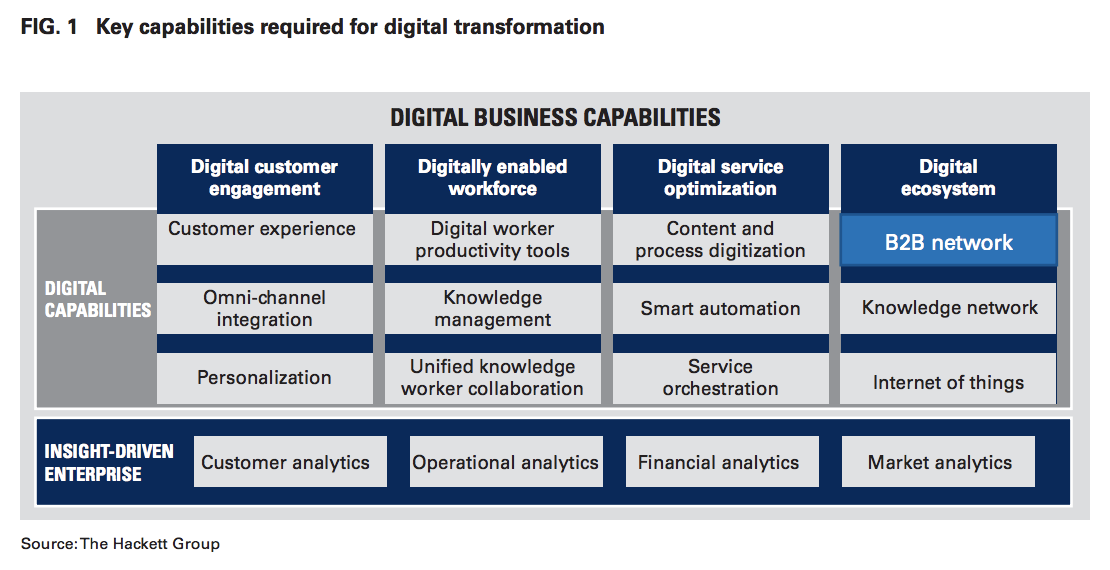- Blog
- How B2B Networks Enable Digital Transformation
How B2B Networks Enable Digital Transformation
71% of purchase-to-pay organisations said they expect the digitalization of B2B transactions will have a more transformational impact on the way they do their jobs than any other trend. Read the role networks play in digital transformation.
What are business networks?
First let’s level set so we’re all on the same page. When referring to business networks, we’re talking about supplier business-to-business (B2B) networks. These are systems used to exchange data electronically between buyers and suppliers. This also applies to a web-based community, connecting trading partners and providing a platform for collaboration, including supplier discovery, e-procurement and e-invoicing.
What’s the buzz around business networks?
Previously, tools like supplier network solutions have been underutilised. But now many procurement organizations are revisiting how these networks are being used and anticipate large increases in their use over the next two to three years. Most notably, plans for supplier networks are moving beyond the basics of managing accounts payable, scheduling, and PO processing. Organizations expect to use them in new ways, such as networking with peers to share data on supplier risk and performance; as a collaboration platform for exchanging demand forecasts and other information; and to identify new suppliers and market opportunities.
What do business networks have to do with digital transformation?
The Hackett Group’s framework for digital transformation includes five key capabilities (Fig. 1):
-
Digital customer engagement
-
A digitally enabled workforce
-
A digital service optimization
-
A digital ecosystem
-
An insights-driven enterprise

As shown in Fig. 1, B2B networks are a core element of the digital ecosystem. In fact, in a Hackett Group survey, 71% of purchase-to-pay organizations said they expect the digitalization of B2B transactions will have a more transformational impact on the way they do their jobs than any other trend (Fig. 2).

However, until their trading partners are digitally enabled, B2B networks will be only as strong as their weakest link. To ensure supplier adoption and help networks reach their full potential, procurement must invest in supplier education and onboarding. This starts with selecting a network provider that can support these value-adding activities. Network connectivity becomes the central hub of digital information transfer between parties.
Adoption also requires a network pricing model that works for both the supplier and buying organization. While some supplier networks charge fees, many are “buyer funded” meaning no direct fees are charged to the supplier for participation. Buying organizations should take this into consideration when choosing a network, as low supplier adoption has been the number one factor contributing to low levels of automation of purchase-to-pay transactions.
What should you look for in a business network?
Here are 3 tips to consider when selecting a business network.
1. Ask about the standard capabilities offered on the network: All of the leading supplier networks are capable of sending and receiving common message types like POs, PO changes, PO acknowledgements, advance ship notices (ASNs), receipt notices, shipment status updates, invoices, remittance advice, etc., in multiple file formats (e.g., XML and EDI). Most solutions also natively support conversion of emails and faxes into a standard file format for import/export purposes. For less advanced suppliers, manual data-entry and upload utilities from an online page are also common. The ability to “flip,” or quickly convert, an existing PO to an invoice using prepopulated data is considered table stakes. Two-way (invoice and PO) and three-way (invoice, PO and goods receipt) matching for invoice validation, reconciliation and approval is also standard.
2. Choose a network that enables ALL of your suppliers: All pertinent information should be available to both buyers and suppliers via a centralized online user interface linking multiple orders to invoices and showing the transaction and status history of each. Most important, the network should support a portfolio of any source format to any output format connectivity options to enable participation by a broad range of suppliers, from the most technologically advanced to those still using paper-based processes. What this means in practice is that your suppliers do not have to change the way the already operate (they only change the address field on their invoice), and the solutions on the business network are able to convert the invoice to the format you prefer. This makes it simple and easy for your suppliers to on-board.
3. Find out more about advanced features supported on the network: Most of the leading networks should have no trouble meeting these requirements. What sets networks apart are their more advanced features and services. It is these differentiators that companies should consider during the selection process to fully enable their digital transformation:
-
Supplier enablement value-added services
-
Buyer enablement
-
Ability to create custom business rules
-
A broader business network and public community
-
Dynamic discounting
-
Interconnectivity among networks
What’s next for business networks?
Over time, networks have been evolving from point applications designed for a single process into platforms for collaboration that any software vendor can build utilities to access in order to extend the base functionality – forming the foundation for continued digital transformation. For industry-specific applications like risk management in financial services, product tracking in pharmaceuticals, or environmental regulatory reporting in high-tech, companies will be able to build a universe of apps or utilities around a central network to extract the maximum amount of value.
